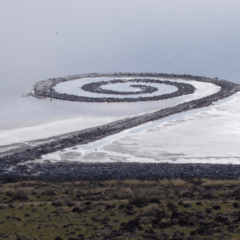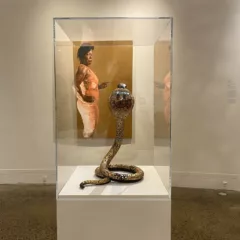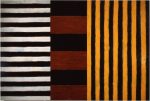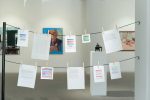The traveler seeks the unique and the rare. Watercolor is delicate. Keep it from the light or it will fade. And where the Hell’s Princeton anyway? At the time of the Revolution Princeton was on the main road from Philadelphia to New York. When we the British made trouble in Philadelphia, Princeton became briefly the American capital.
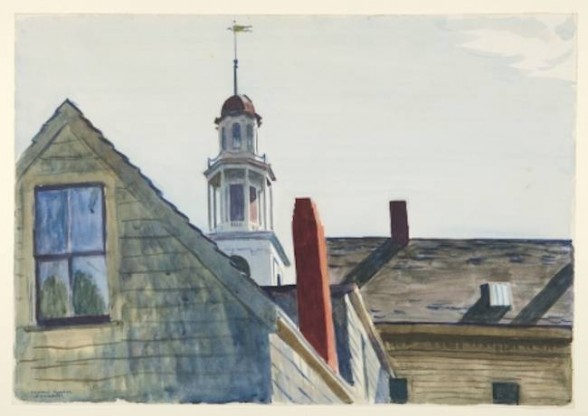
The delicate but disdained medium
Watercolor has been disdained as the art of women and children. But Deborah Smith Taber‘s (1796-1879) portraits of family and friends, if a tad awkward, are rich with feeling; her 13-month-old niece Mehitable Eddy Taber (1830) is lovable and endearing. In colonial times and the early Republic watercolor was generally either a tool of the lithographer and industrial designer. Thus Thomas Eakins as a 16-year-old uncannily represented a lathe. Audubon’s Birds of America began as watercolor field sketches. His Yellow-throated Vireo opens the show. My uncle was a biology professor at Columbia; his lab was decorated with 19th century botanical watercolors. My uncle specialized in spiders not plants so he couldn’t fill me in on the botanist or his field trip.
Ruskin, the Civil War and watercolor’s simplicity
Then the 1860s brought the American Civil War and John Ruskin and the Pre-Raphaelites. More than Yale, Harvard, Columbia, and of course McGill (pure as the driven snow and the alma mater of me and my uncle), Princeton derived its wealth from the South and slavery. A certain Mr. Prospect, for instance, had a thousand slaves and his summer residence on the Princeton campus. That Italianate mansion is now the Faculty Club. Prospect Avenue with its fancy ‘eating clubs’ was not named allegorically.
Ruskin preferred watercolor to slick oil. Watercolor was simpler, more direct, more primal, more sincere. Weird guy. Liked the primal and direct but didn’t know about pubic hair. Thought a nekked girl was white all over like marble. That may now be the case, at least with Caucasians, thanks to bikini waxes and pornographic expectations. Ebony and Ivy is the book to read on slavery and American universities. The American Watercolor Society was founded in 1866. But it admitted women! Can you imagine? Most painters therefore refused to join.
Ruskin also preferred Gothic to High Victorian. Princeton soon re-did itself in Collegiate Gothic. As it got rich and then even richer Princeton assiduously collected watercolor.
Winslow Homer was the greatest American watercolorist. Edwin Hopper’s Universalist Church is the most majestic work in the show and its poster. Childe Hassam represents Impressionism. Impressionism, even more than the Pre-Raphaelite, is good in watercolor. Today Geoffrey Hendricks does watercolors of the night sky while Claes Oldenburg does blueberry pie.
A show that provides an overview of the medium
This history of American watercolor features the choicest examples by the greatest American artists. It is a history of American art from a particular technical perspective. It’s certainly worth a trip to Princeton even though Princeton is no longer on the road from Philly to New York. The show closes August 26.
Princeton’s sculpture gardens and contemporary art
Across the hall from American Watercolor is Collecting Contemporary (1960-2015): Elizabeth Murray, Jean-Michel Basquiat, Andy Warhol &c. in oil and other media. It closes at the end of September.
And the Princeton campus is one of the world’s great sculpture gardens. The Lewis Library was designed by Frank Gehry; its exit is essentially two Richard Serra corridors. Ai Weiwei’s twelve astrological sculptures in front the Woodrow Wilson School of Politics are magnificent. After the watercolor show closes a Starn brothers sculpture will be unveiled. They’ve been working on it in all weather for months.
Think of Princeton as the apex of a triangle.
Painting on Paper: American Watercolors at Princeton, to Aug. 30. Princeton University Art Museum, Princeton, NJ. http://artmuseum.princeton.edu/art/exhibitions/1653
—Michael Andre is a poet based in Princeton, NJ. He is ranked #3 in this recent list of “Top 10 Best 21-Century Poets You Must Know.” You can find more of his art writings at his author page on Artblog and check out more of his musings on his blog, Unmuzzled Ox.


